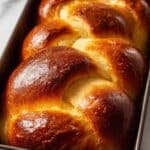Description
This classic French brioche recipe delivers a rich, tender, and buttery bread with a delicate crust and a soft, fluffy crumb. The dough is enriched with butter and eggs, carefully kneaded for gluten development, then shaped into a braided loaf and baked to golden perfection. Perfect for breakfast, brunch, or as a base for sweet and savory dishes, this brioche boasts a subtle sweetness and a luxurious texture that tears apart like cotton candy.
Ingredients
Scale
Dough
- 2 1/2 tsp instant/rapid rise dried yeast
- 4 tbsp warm full-fat milk
- 2 cups plain/all purpose flour (not bread flour)
- 3 1/2 tbsp caster/superfine sugar
- 1/2 cup eggs (approx. 2 1/2 eggs), lightly whisked, at room temperature
- 1 tsp cooking/kosher salt (not table salt)
- 150g / 10.5 tbsp unsalted butter, softened and cut into 1.25 cm / 1/2″ pieces
Other
- Oil spray (neutral flavored such as canola or vegetable oil)
- 1/2 leftover egg, lightly whisked (for egg wash)
Instructions
- Bloom yeast: In a small bowl, mix 1 tsp sugar, yeast, and warm milk together. Cover with cling wrap and set aside in a warm place for 10 minutes until the mixture becomes foamy to activate the yeast.
- Make dough: Using a stand mixer fitted with a dough hook, combine the flour, whisked eggs, salt, remaining sugar, and bloomed yeast at Speed 1 until ingredients are combined.
- Initial mixing: Continue mixing at Speed 1 for 5 minutes, then increase to Speed 2 and mix for an additional 10 minutes to develop the gluten.
- Slowly add butter: With mixer still at Speed 2, gradually add butter cubes over 90 seconds to 2 minutes, allowing the fat to be partially incorporated while mixing.
- Incorporate butter fully: Keep mixing at Speed 2 for about 1 minute until butter is fully incorporated. The dough will initially be pasty and sticky.
- Extended mixing: Continue mixing at Speed 2 for 20 minutes, scraping down the sides of the bowl regularly. The dough should become soft, elastic, and come together around the dough hook, passing the “window pane” test.
- First rise: Form dough into a ball and place back into the stand mixer bowl. Cover with cling wrap and let rise in a warm place for 2 hours until doubled in size.
- Divide and shape: Punch down dough to release air. Turn out onto a lightly floured surface, fold edges in six times, shape into a log, then divide into three equal balls (~225g each).
- Chill dough: Place dough balls on oiled parchment in a deep container or roasting pan, cover with cling wrap, and refrigerate for 1.5 hours. This step helps dough handle better and smooths the surface.
- Braid dough: Remove dough from fridge, roll each ball into 35 cm / 14″ logs. Braid the three logs and tuck ends under neatly.
- Prepare loaf pan: Spray an 21.5 x 11 cm (8.5 x 4.3″) loaf pan with oil spray, place braided dough inside. Lightly oil cling wrap and cover dough.
- Second rise: Let the dough rise in a warm place for 3 hours or until just over doubled in size.
- Preheat oven: When dough is nearly ready, preheat oven to 200°C / 390°F (180°C fan) and position oven rack in the lowest third.
- Egg wash: Gently brush the surface of the brioche with the leftover whisked egg to achieve a glossy crust.
- Bake uncovered: Bake the brioche uncovered for 15 minutes until deeply golden brown.
- Bake covered: Remove from oven, cover loosely with foil, and bake for another 20 minutes until internal temperature reaches 88°C / 190°F.
- Cool: Immediately turn the brioche out of the pan onto a cooling rack. Allow it to cool for at least 45 minutes before slicing or tearing to serve while still warm.
- Serving suggestion: Serve warm with butter and jam or toast slices. Brioche can also be enjoyed in various sweet and savory preparations as per taste.
Notes
- Use instant yeast activated by blooming in warm milk for a softer, higher-rise loaf; dry active yeast works similarly at equal quantities.
- Full fat/whole milk improves dough texture.
- All-purpose flour yields a softer crumb than bread flour in brioche.
- Caster sugar integrates better but granulated sugar can substitute.
- Accurate egg measurement ensures dough consistency and is key for proper texture.
- If only table salt is available, reduce salt quantity to 3/4 tsp.
- Butter should be softened but not melting to avoid greasy dough.
- Long kneading is necessary to develop gluten affected by high-fat dough.
- Perform the window pane test to confirm proper gluten development; knead longer if dough breaks.
- Add butter gradually for optimal incorporation.
- If dough is too sticky after mixing, add flour one tablespoon at a time; if too crumbly, add warm milk carefully or restart.
- The fridge step is optional but improves handling and appearance.
- Second rise should result in dough rising about 1 cm above the pan rim.
- Bake brioche to an internal temperature of 88°C to accommodate the enriched dough.
- To reheat, wrap loaf in foil and warm at 180°C for 10-15 minutes.
- Brioche freezes well up to 3 months; thaw and reheat before serving.
- A food processor method exists for faster dough preparation.
- Overnight refrigerated rise of divided dough is possible, extending second rise to about 4 hours.
- Recipe source: collaboration with French chef Jean-Baptiste Alexandre and classic culinary references.
Nutrition
- Serving Size: 1 slice (1/16th of loaf)
- Calories: 210
- Sugar: 4 g
- Sodium: 150 mg
- Fat: 11 g
- Saturated Fat: 7 g
- Unsaturated Fat: 3 g
- Trans Fat: 0 g
- Carbohydrates: 22 g
- Fiber: 1 g
- Protein: 5 g
- Cholesterol: 60 mg

